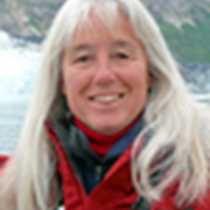Tracy Arm Fjord, Southeast Alaska
You know that it’s a good day when you see a humpback whale at the end of a rainbow. This was our omen as we turned east from Stephens Passage into Tracy Arm, a narrow, twisting, glacier-carved waterway with spectacular scenery and two tidewater glaciers that spill from the Coast Mountains into the deep, salty water at the head of the inlet. We spent the morning cruising toward that destination, with a few distractions along the way.
First, a waterfall caught our attention, and Chief Mate Patrick maneuvered for a close look at the pothole that has formed in the rock wall from torrents of water tumbling small stones against the bedrock. An adult bald eagle drying its wings watched from its perch, almost at eye-level, as we slid by. Farther down, we spied a black bear that had come down to the shore at low tide. We quietly observed as it ate barnacles off the smooth, glacier-polished rocks, looking up only twice but still not disturbed by our looming ship. With snow still on the slopes and vegetation just scarcely beginning to emerge, the creatures of the intertidal zone are what the bears find most available at this time. As the season progresses, the bears will vary their diet according to changes in food accessibility and supply. Through our binoculars, we also found mountain goats looking down from the precipitous rock slopes above.
In the afternoon we boarded Zodiacs for a water-level view of Sawyer Glacier and the icebergs spawned in the process of “calving” off the terminus of the river of ice. It is quite a thrill to experience the “white thunder” from close (but safe) proximity. The surrounding landforms attest to the power of water (frozen and otherwise) and we felt small and humbled as we imagined this area once covered with several thousand feet of ice. As the glaciers recede, newly exposed rock and gravel create habitat in which Arctic terns can nest. Courtship procedures are underway for these birds as they hurry to raise their families in time to migrate to the other end of the planet.
The Sea Bird slowly made its way back down the fjord through thick “growlers” of ice. We enjoyed a pleasant and relaxed afternoon on the final day of our voyage through Coastal British Columbia and Southeast Alaska.
You know that it’s a good day when you see a humpback whale at the end of a rainbow. This was our omen as we turned east from Stephens Passage into Tracy Arm, a narrow, twisting, glacier-carved waterway with spectacular scenery and two tidewater glaciers that spill from the Coast Mountains into the deep, salty water at the head of the inlet. We spent the morning cruising toward that destination, with a few distractions along the way.
First, a waterfall caught our attention, and Chief Mate Patrick maneuvered for a close look at the pothole that has formed in the rock wall from torrents of water tumbling small stones against the bedrock. An adult bald eagle drying its wings watched from its perch, almost at eye-level, as we slid by. Farther down, we spied a black bear that had come down to the shore at low tide. We quietly observed as it ate barnacles off the smooth, glacier-polished rocks, looking up only twice but still not disturbed by our looming ship. With snow still on the slopes and vegetation just scarcely beginning to emerge, the creatures of the intertidal zone are what the bears find most available at this time. As the season progresses, the bears will vary their diet according to changes in food accessibility and supply. Through our binoculars, we also found mountain goats looking down from the precipitous rock slopes above.
In the afternoon we boarded Zodiacs for a water-level view of Sawyer Glacier and the icebergs spawned in the process of “calving” off the terminus of the river of ice. It is quite a thrill to experience the “white thunder” from close (but safe) proximity. The surrounding landforms attest to the power of water (frozen and otherwise) and we felt small and humbled as we imagined this area once covered with several thousand feet of ice. As the glaciers recede, newly exposed rock and gravel create habitat in which Arctic terns can nest. Courtship procedures are underway for these birds as they hurry to raise their families in time to migrate to the other end of the planet.
The Sea Bird slowly made its way back down the fjord through thick “growlers” of ice. We enjoyed a pleasant and relaxed afternoon on the final day of our voyage through Coastal British Columbia and Southeast Alaska.



